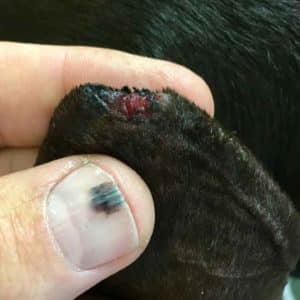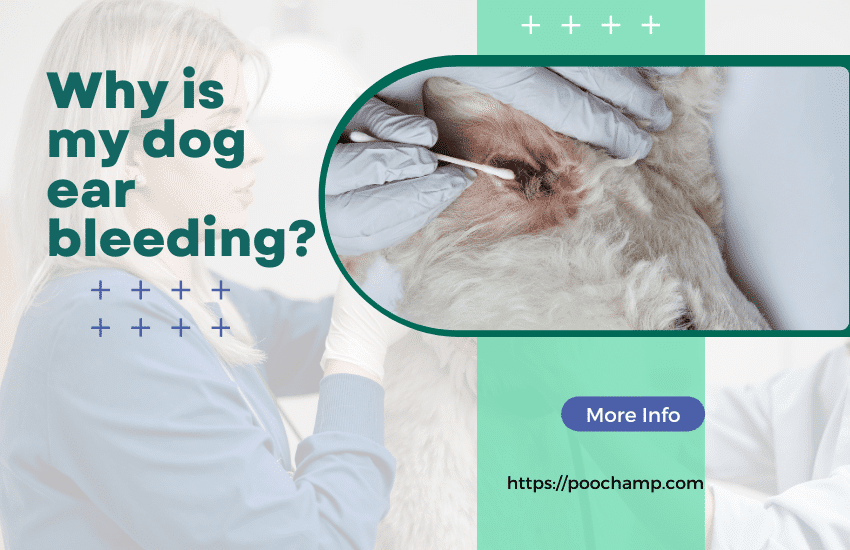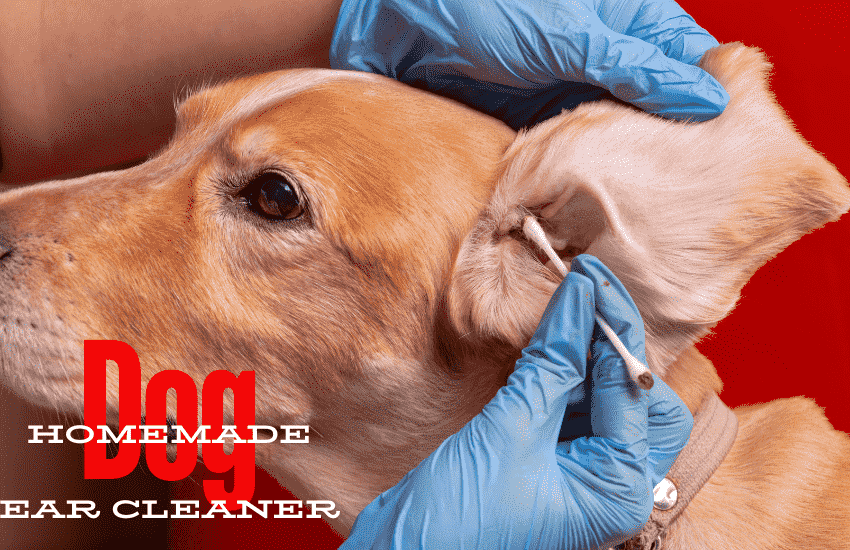why is my dog ear bleeding?-Your dog’s ear bleeding can be due to injury, infection, or parasites. Prompt veterinary attention is essential to diagnose and treat the underlying cause.
Dog owners often experience anxiety when they notice their pet’s ear bleeding, and rightly so. Ear bleeding in dogs can indicate various health issues, ranging from minor irritations to serious conditions. It’s important to act quickly, as ears are sensitive organs, and bleeding can lead to complications if left untreated.
Understanding the common causes such as ear infections, mites, foreign bodies, or trauma can help in addressing the problem effectively. Regular ear checks are part of responsible pet care, ensuring any sign of distress is caught early. Consulting a veterinarian provides a proper diagnosis and treatment plan, ensuring your furry friend’s health and comfort are restored.
Why is my dog ear bleeding?
Seeing your dog’s ear bleeding can be scary. There are a few reasons why this might happen. This post will talk about the most common causes. Understanding them helps you act fast to help your furry friend.
Ear Infections
An ear infection is a top reason for dog ear bleeding. It can make dogs scratch their ears a lot. This scratching can lead to bleeding. Here’s what you need to know about ear infections:
- Bacteria and yeast can cause infections.
- They make the ear itchy and smelly.
- Redness and swelling often happen.
Signs your dog might have an ear infection include:
| Sign | Explanation |
|---|---|
| Shaking head | Trying to get rid of discomfort. |
| Scratching ear | Itchy ears cause scratching. |
| Bad smell | Caused by bacteria or yeast. |
| Discharge | Yellow, brown, or bloody discharge. |
Ear infections need a vet’s care. They can check your dog’s ear bleeding inside and suggest treatment.
Foreign Objects
Foreign objects in your dog’s ear can also cause bleeding. Things like grass seeds, tiny sticks, or even bugs can get stuck. This makes dogs scratch their ears, leading to dog ear bleeding from scratching. Here’s more on foreign objects:
- They can be hard to see.
- They cause pain, redness, and swelling.
- A vet should remove them safely.
Signs your dog might have something stuck in their ear include:
- Shaking their head a lot.
- Whining or crying when they touch their ear.
- Trying to rub their ear on the ground or furniture.
- Bleeding or discharge from the ear.
If you think your dog has a foreign object in their ear, see a vet. Don’t try to remove it yourself. You could push it deeper or hurt your dog’s ear more.
Symptoms To Watch For
Symptoms to Watch For can be alarming when your dog has a bleeding ear. It’s crucial to spot these early signs. Quick action can prevent more harm. Bleeding can mean several issues, from simple scratches to severe infections. Keep your eyes open for these symptoms to ensure your dog stays healthy and happy.
Visible Blood In Ear
Seeing blood in your dog’s ear is a clear sign of trouble. But don’t panic. Here’s what to look for:
- Blood spots on their bedding or places they rest
- Red stains around the ear area on their fur
- Droplets or pools of blood inside the ear canal
These signs suggest your dog’s ear needs immediate attention. A vet will help you figure out the cause, which could range from ear mites to injuries. A table below shows common causes linked to bleeding:
| Cause | Symptoms | Action |
|---|---|---|
| Ear Mites | Dark, gritty discharge in the ear | See a vet for medication |
| Scratches | Minor visible cuts | Clean area, prevent infection |
| Infections | Swelling, pus, bad smell | Immediate vet care |
Scratching Or Shaking Head
If your dog keeps scratching or shaking their head, take note. It’s a big clue that their ear hurts. Look for these behaviors:
- Scratching at the ear more than usual
- Head shaking as if trying to get something out
- Whining when they touch their ear
When To Seek Veterinary Help
Seeing your dog’s ear bleeding can be alarming. You might wonder what happened and what to do next. Some ear injuries might seem minor, but they can lead to serious complications if left untreated. Knowing when to seek veterinary help is crucial for your dog’s health. Let’s explore the signs that indicate it’s time to get professional care.
Persistent Bleeding
If you notice your dog’s ear bleeding, it’s essential to monitor the situation closely. How to stop a dog’s ear from bleeding depends on the cause and severity. Here’s what to watch for:
- Amount of blood: A few drops may be manageable at home, but more requires attention.
- Duration: Bleeding that doesn’t stop within a few minutes needs a vet’s care.
- Discomfort: If your dog seems in pain or can’t stop scratching, it’s time to act.
Bleeding can stem from injuries, infections, or foreign bodies. Here’s a brief guide:
| Cause | Action |
|---|---|
| Injury | Clean the area and apply pressure. See a vet if bleeding persists. |
| Infection | Look for swelling or discharge. Vet visit required. |
| Foreign Object | Do not remove it yourself. Go to the vet immediately. |
Seek veterinary help if the bleeding doesn’t stop or if you’re unsure about the cause. They can provide proper treatment and stop the dog ear bleeding safely.
Foul Odor From Ear
A foul odor from a dog’s ear is a telltale sign of an underlying issue. This unpleasant smell is often paired with other symptoms:
- Yellow or brown discharge
- Swelling or redness
- Head shaking or tilting
These signs suggest an infection or a foreign body trapped inside the ear. A vet can diagnose and treat the problem. Here’s what they might do:
| Symptom | Possible Cause | Treatment |
|---|---|---|
| Foul Odor | Infection | Medication and cleaning |
| Discharge | Yeast or Bacteria | Specific drugs and care |
| Redness | Allergies or Mites | Address the root cause |
Do not attempt to treat a foul smell or dog ear bleeding at home without guidance. A vet can provide safe and effective treatment, ensuring your dog’s ear heals properly and comfortably.

Credit: www.walkervillevet.com.au
Home Care Tips
Seeing your furry friend in distress can be alarming, especially if your dog’s ear is bleeding. This condition may arise due to various reasons like infections, injuries, or parasites. Understanding how to treat a bleeding dog ear at home can help manage the situation before you visit the vet. Here are some essential home care tips to follow.
Gently Clean your dog Ear
When you notice your dog’s ear bleeding, gentle cleaning is crucial. It helps in preventing infection and allows you to get a better look at the injury. Follow these steps:
- Wear gloves: Protect your hands and ensure hygiene.
- Prepare a cleaning solution: Mix a vet-approved ear cleaner with warm water.
- Soak a cotton ball: Dip it in the solution but do not oversaturate.
- Wipe the ear: Clean the outer ear gently, avoiding the ear canal.
- Check for debris: Look for signs of mites, ticks, or foreign objects.
If the bleeding does not stop, apply pressure with a clean cloth. This might help in how to stop a dog’s ear from bleeding.
| Action | Description |
|---|---|
| Inspect | Look for the source of bleeding inside the ear. |
| Clean | Use the solution to remove any blood or discharge. |
| Apply Pressure | Gently press on the bleeding area if it’s accessible. |
After cleaning, if the ear continues bleeding or your dog is shaking its head persistently, it’s crucial to seek veterinary care. The dog ear bleeding shaking head symptom could indicate a deeper issue.
Avoid Using Q-tips
It’s essential to know how to stop bleeding ear on dog without causing further harm. One common mistake is using Q-tips, which can damage your dog’s ear canal and worsen the bleeding. Consider these points:
- Surface cleaning: Stick to cleaning only the parts of the ear you can see.
- Safety first: Avoid inserting anything into the ear canal.
- Seek professional help: If the injury is deep or if there’s persistent bleeding.
Using Q-tips can push debris deeper and puncture the ear drum, leading to more serious issues. For dogs ear bleeding inside, a vet can safely examine and treat the ear.
| Tool | Use |
|---|---|
| Cotton Balls | Safe for cleaning visible parts of the ear. |
| Q-Tips | Do not use; can cause damage. |
| Cloth | Apply pressure if needed to help stop bleeding. |
If your dog’s ear is bleeding, remember to avoid Q-tips and opt for safer alternatives. While minor injuries may heal with proper home care, my dog’s ear is bleeding can be a sign of a more severe condition. Always consult your vet for the best course of action.
Preventive Measures
Discovering your dog’s ear bleeding can be alarming. Often, this issue stems from injuries or health conditions like infections and parasites. To keep your furry friend happy and healthy, proactive steps are crucial. Grooming is important to avoid any possible infection, that’s why making a wash routine is crucial. Let’s dive into how regular checks and upkeep can prevent ear bleeding.
Regular Ear Inspections
Staying ahead of ear problems means inspecting your dog’s ears consistently. Check for redness, discharge, or an unusual smell. These signs might point to an issue needing attention. Here’s a simple routine to follow:
- Frequency: Look inside your dog’s ears weekly.
- Light: Use a flashlight to see clearly.
- Gentleness: Be soft to avoid hurting your dog.
During inspections, keep an eye out for:
- Wax buildup
- Foreign objects
- Parasites like ear mites
- Swelling or cuts
Addressing these early can prevent bleeding and more severe conditions. A table of common signs and actions can guide you:
| Signs to Look For | Immediate Actions |
|---|---|
| Bad odor | Consult a vet |
| Excessive scratching | Clean gently, then vet visit |
| Redness or swelling | Stop any scratching, see vet |
| Discharge | Identify type and contact vet |
Proper Ear Maintenance
Regular care keeps your dog’s ears healthy. Start with a vet-approved cleaner. Apply it to a cotton ball, not directly in the ear canal. Wipe the outer ear gently, never pushing far inside. Follow this routine:
- Squeeze cleaner onto cotton ball.
- Wipe outer ear and folds.
- Let dog shake its head.
- Remove loosened debris.
- Praise your dog for staying calm.
Keep these tips in mind:
- Avoid water: Keep ears dry during baths.
- Trim hair: This prevents matting and infections.
- Professional help: Seek groomers or vets for deeper cleaning.
Good maintenance also includes a healthy diet and regular check-ups. This supports your dog’s overall health, including its ears. By staying vigilant with these steps, you can greatly reduce the risk of ear bleeding and ensure your dog remains comfortable and happy.

Credit: www.innovetpet.com
Frequently Asked Questions
What Causes A Dog’s Ear To Bleed?
A dog’s ear may bleed due to injuries, infections, parasites, or tumors. Injuries can be from scratching or accidents. Infections like otitis can inflame the ear canal. Parasites such as ear mites also lead to irritation. In severe cases, tumors might be the culprit.
How Can I Stop My Dog’s Ear From Bleeding?
First, remain calm. Gently clean the visible blood with a damp cloth. Avoid probing the ear. Apply a light bandage if necessary. Avoid cotton swabs. Consult a vet immediately for proper diagnosis and treatment to prevent further damage or infection.
Is A Bleeding Ear An Emergency For Dogs?
Yes, a bleeding ear can be an emergency for dogs. It often indicates underlying issues that need immediate veterinary attention. Quick treatment can prevent complications such as hearing loss or deeper infections. It’s important to see a vet as soon as possible.
Can Ear Infections Cause Bleeding In Dogs?
Ear infections can indeed cause bleeding in dogs. The infections lead to inflammation and irritation in the ear canal, which can result in bleeding, especially if the dog scratches or shakes its head vigorously. Veterinary treatment is necessary to resolve the infection.
Conclusion
Discovering your dog’s ear bleeding can be alarming. It’s crucial to identify the cause promptly and seek veterinary care. From infections to injuries, various reasons could be behind this issue. Remember, early intervention can prevent more serious complications. Keep a close eye on your furry friend’s health for their comfort and well-being.







